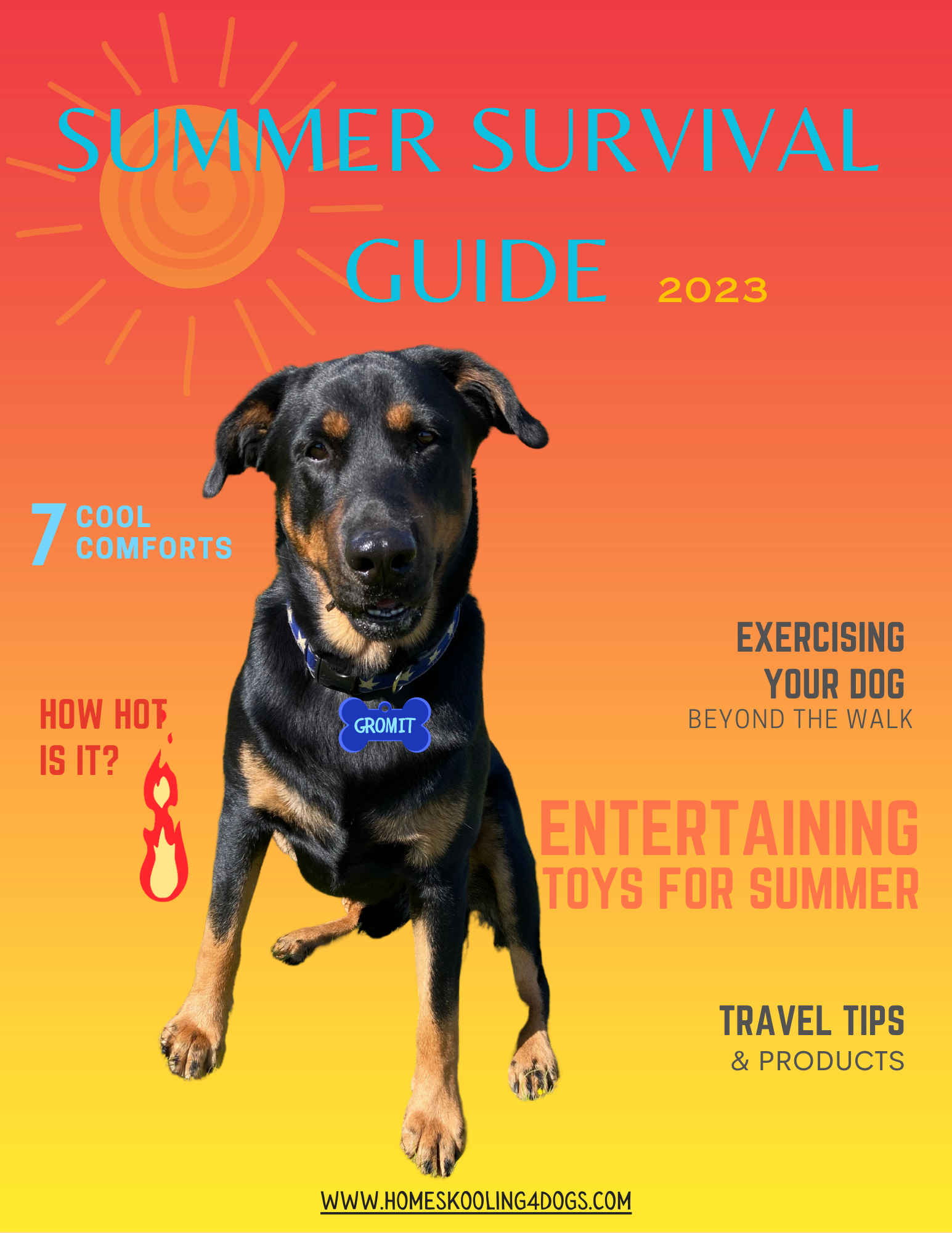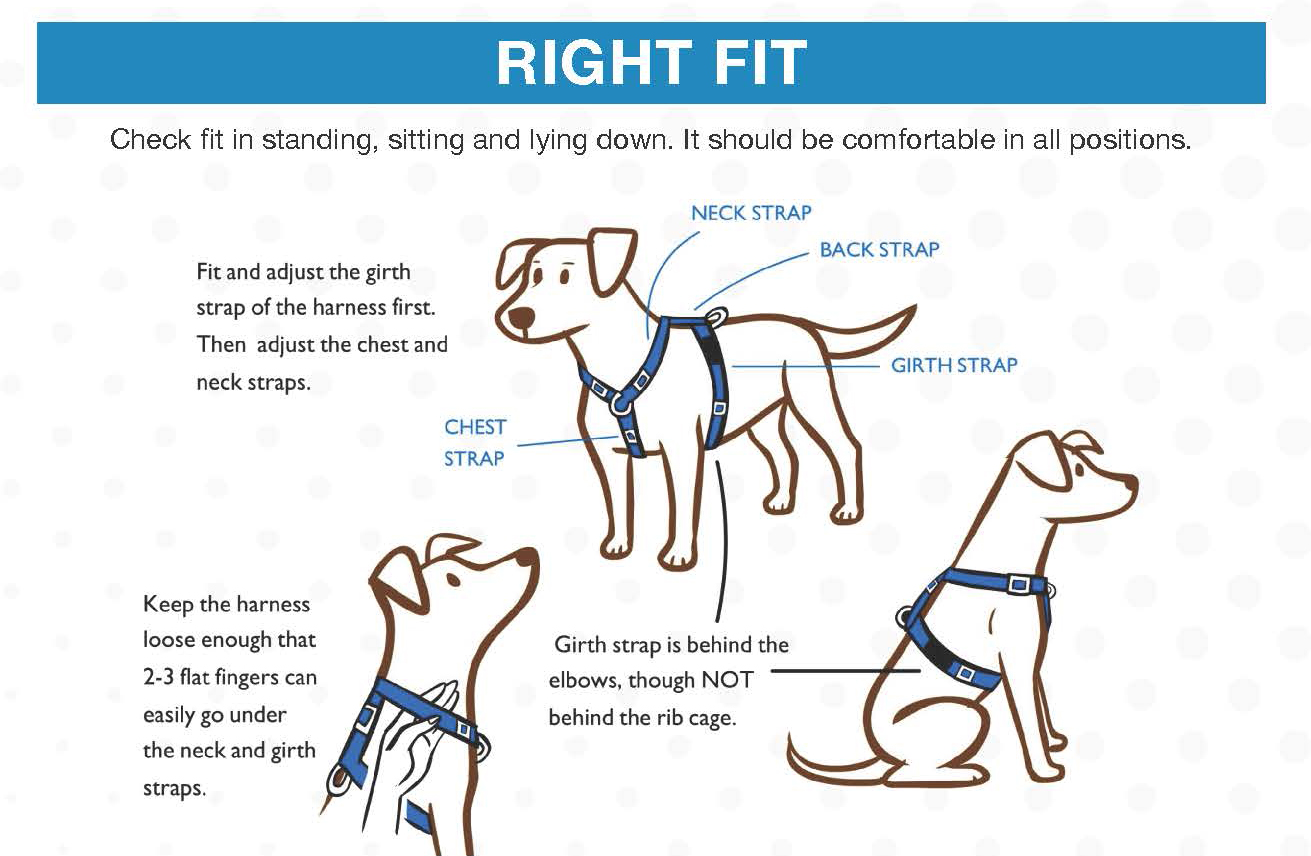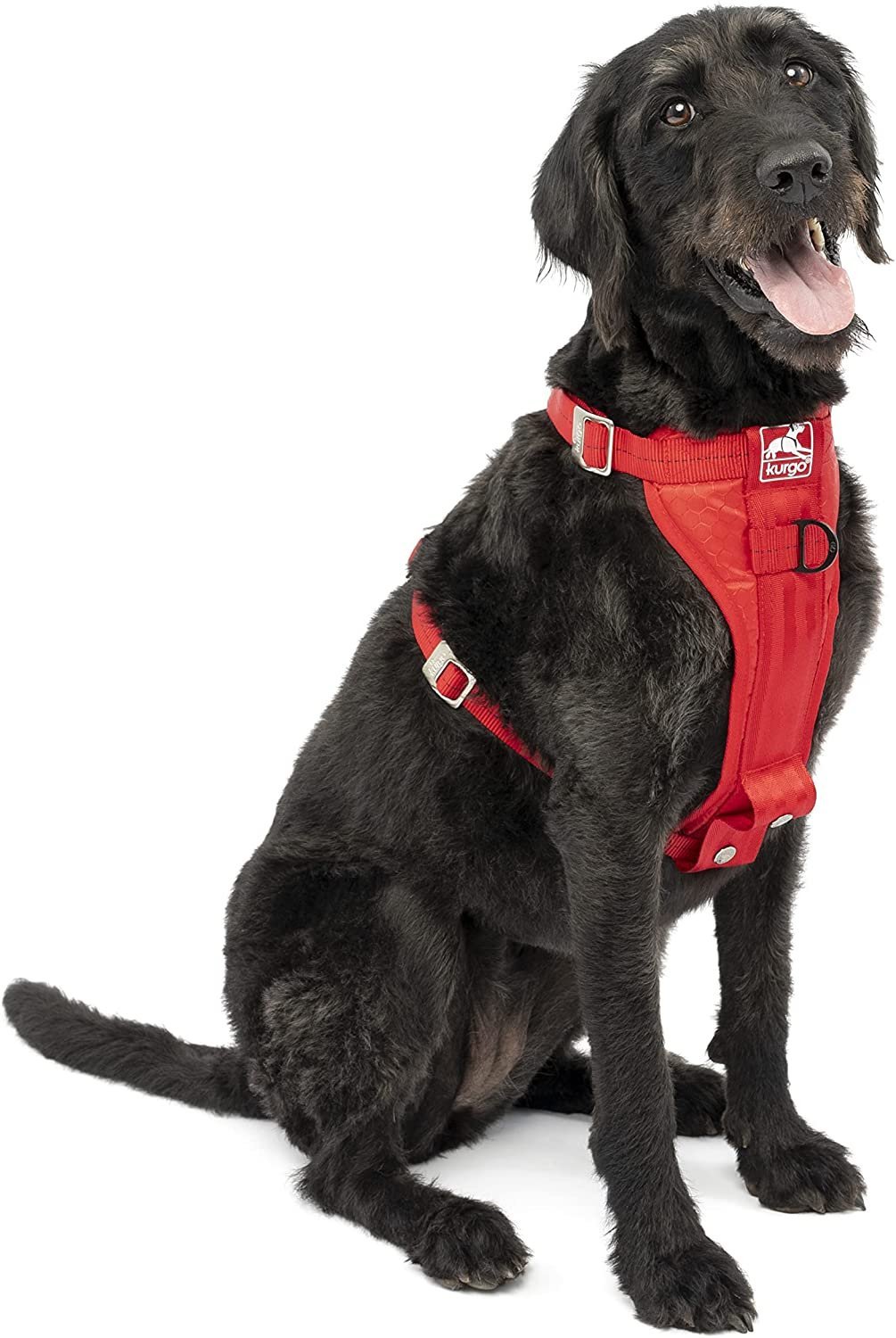Harnesses
How to train a dog to Walk on a Leash Without Pulling.
Harness Types
How To Choose A Harness
No-Pull Harness
Recommended Harnesses
Control Harness
Car Safety Harness
Dog-lifting mobility harness
Many people choose a harness because their dog pulls on leash and they want to avoid pressure on the dog’s neck. If this is the case for choosing a harness it is generally better to teach your dog to walk on a leash without pulling. You can teach a dog to walk nicely on a leash quickly with good technique, not training “tools”, treats or corrections. Training Collars
Harnesses are recommended for tracking, running, urban mushing, vehicle travel, and for dogs that have; tracheal collapse, laryngeal paralysis, obstructive airway disease or neurological problems involving the neck, such as wobblers disease. When selecting a harness be selective because there are lots of poorly designed harnesses recommended by trainers, and others. Select a properly fitted “Y” harnesses because these are designed properly for the dog’s anatomy.
"Dogs with high shoulders should never work in harness. A harness bearing down and rubbing on high shoulders can cause intensely painful bone bruises." - Structure in Action by Pat Hastings and Wendy E. Wallace, DVM, cVA
Be mindful some dogs have body sensitivity issues and will not like the sensation of a harness. Suzanne Clothier works with guide dogs for the blind organizations and she says this is more common than we might think and a number of dogs have been washed out of the program because of it. Some dogs have a “harness sensitivity” which can cause them to “freeze in place” and not move and others it alters their movement. With other dogs the level of discomfort raises to a level after they have been walking and they refuse to continue or they may struggle against the leash out of frustration. A dog can also suffer from a condition like Osteochondritis dissecans which is an inflammatory condition that affects the cartilage and shoulder joint but can also affect the elbow, hip or knees.
To Harness Or Not To Harness? That Is The Question...
by Chris Zink, DVM PhD DACVSMR
Effect of harness design on the biomechanics of domestic dogs (2023)
HOW TO CHOOSE A HARNESS
Harnesses have differing functions and are designed for specific purposes so its important to choose a properly designed and properly fitted harness.
Broadly speaking harnesses can be placed in one of three categories.
Working - tracking, carting, drafting, freight pulls, guide dogs
Companion – walking, skijoring, running, urban mushing
Control - Non-Restrictive / (Figure 4) Front-clip restrictive harnesses e.g. Blue 9 Harness
If using a front attachment harness understand that a dog’s rib cage is not supported with the stabilization of collarbones so you need to minimize substantial torquing forces.
“Most owners and handlers do not observe an obvious alteration in gait while their dog is wearing a harness.” [5] but “both restrictive and non-restrictive harnesses alter dogs’ gaits” [2]
“Gait alterations caused by a harness may contribute to long-term repetitive strain, which could either cause or predispose dogs to injury.” [5]
Control - Restrictive - (Figure 3) Not Recommended (No Pull Harnesses) – Front-clip restrictive harnesses
Not Recommended: Easy Walk, Freedom Harness, Sense-ation Harness, Sure-Fit Harness, Wonder Walker Body Halter, Walk Your Dog With Love Harness, DT Universal No-PUll Plus Harness, Comfort Flex, and many more!
“both restrictive and non-restrictive harnesses alter dogs’ gaits” [2]
“Most owners and handlers do not observe an obvious alteration in gait while their dog is wearing a harness.” [5] but “both restrictive and non-restrictive harnesses alter dogs’ gaits” [2]
“Gait alterations caused by a harness may contribute to long-term repetitive strain, which could either cause or predispose dogs to injury.” [5]
For most dogs a collar is recommended. When choosing a working or companion harness choose a Y harness (non-restrictive) that is designed and fitted tightly around the neck so it doesn’t slide back and put pressure on the dog’s shoulders” altering your dog’s gait which can result in injury over time. [4] (M. Christine Zink, D.V.M., PH.D.)
The “Y” harness (Figure 5) has “straps that fit tightly around each side of the dog’s neck, almost like a collar, and meet a third strap that runs under the dog's chest. The point at which the neck and chest meet forms a "Y" that sits right on the manubrium - the part of the sternum (chest bone) that is closest to the front of the dog. The “Y” harness places the majority of the pressure from the harness “on the manubrium, which is a very stable bone that supports the entire dog's body.” [3] The neck straps should be snug so they do not slip down and put pressure on the shoulders. The center of the Y strap on the front neck should not sit high or low on the chest. (See figure 6 https://www.caninesports.com/uploads/1/5/3/1/15319800/harnesses_for_agility_dogs.pdf)
Figure 2 NECK STRAP SHOULD BE ABOVE THE SHOULDERS AND GIRTH STRAP ABOUT 2" BEHIND FRONT LEGS.
Figure 1 "Y" STRAPS (GREEN) FITTED TO AVOID STRAPS ON - shoulders, biceps and supraspinatus tendons
https://anatomywiki101.com/canine-muscle-anatomy-chart/canine-muscle-anatomy-chart-canine-muscle-structure-anatomy-of-the-dog-dog-index-vet-tech/
“No part of the harness should “cross over the dog's shoulder blade (scapula) or upper arm (humerus). (Figure 1 & 2) [3] A properly designed and well-fitted harness does not have restrictive straps that sit on top the biceps and supraspinatus tendons. (Figure 1) A harness should permit the dog’s legs to have full range of motion to extend forward and reach back unrestricted. The girth strap should be fitted about 2” behind the front legs so it’s not pushing into the elbows. (Figure 2)
No-Pull Restrictive Harness (Not recommended)
"No-pull” restrictive type of harness are potentially damaging to the front legs.
“Harnesses that limit shoulder extension and restrict forelimb excursion could predispose dogs to shoulder tendinopathies.” [1]
Its important to understand that poorly designed harnesses and well-designed harnesses fitted improperly can cause damage and discomfort. You would not wear a poorly fitted backpack, shoes, or jacket that limited your range of motion so don’t subject your dog to a restrictive harness or an improperly fitted harness.
As a specialist in canine sports medicine Dr. M. Christine Zink* has significant concerns about the use of harnesses that wrap around the front of dog’s forelegs. (Whole Dog Journal May 2013) (Figures 1 & 3)
“Gait alterations caused by a harness may contribute to long-term repetitive strain, which could either cause or predispose dogs to injury.” [5]
These are examples of no-pull harness that are NOT RECOMMENDED.
Freedom No-Pull harness,
Easy Walk harness
Softouch Sense-action harness
Positively No-Pull Harness
Wonder Walker N0-Pull Harness
Sporn No-Pull harness
This is an excellent article regarding harness fit.
Reflections on chest harnesses Tierphysiotherapie Brigitte Jost·Monday, January 29, 2018
Harnesses We Use And Recommend
Urban Trail Harness - Alpine Outfitters
The Urban Trail Half Harness is perfect for use in a variety of dog activities in addition to mushing, such as scootering, bikejoring, roller blading, canicross, skijoring, tracking, and hiking. This harness works equally well for walks around the neighborhood. This harness extends only part way down the back to accommodate the steeper pull angle associated with biking and scootering.
Pulling pressure is on dog's chest, not neck and shoulder, and because it reaches half way down the back, it eliminates downward pressure a standard harness puts on dog's hindquarters.
Rotates freely around dog's torso, thereby helping to reduce "crabbing".
Good for big dogs
Great for senior dogs, easy on the hips.
Fully padded with premium quality Polartec Polar Fleece and is extremely lightweight, durable, and is machine washable. Contrary to appearance and perception, Polar Fleece does not readily absorb moisture; due to its hydrophobic nature, it only retains 1% of its weight in water.
Distance Harness - Howling Dog Alaska
The Howling Dog Alaska Distance Harness is the harness of choice for skijoring, bikejoring, canicross, scootering and dog trekking. It is an ideal harness for the use with BTL and Springer bike attachment.
This harness is one of the most popular harnesses for long distance mushing.
The Distance Harness only reaches about 1/3 down the dog's body, which eliminates the pressure on the dog's hips while pulling. Therefore it makes this harness an excellent choice of a harness for any dog with lower back problems. Crabbing dogs (dogs running sideways) will straighten out. Our harness comes highly recommended by Wes Rau, top canine physical therapist.
Blue-( Balance Harness
Control Harness (NON-RESTRICTIVE)
Blue-9 Balance Harness (non-restrictive). https://www.blue-9.com/pages/balance-harness/ The Blue-9 Balance Harness was appropriately designed taking canine anatomy into consideration. Fitted properly the harness neck straps fit around the neck so they do not slip and put pressure on the shoulders. The Balance Harness does not have restrictive straps that sit on top the biceps and supraspinatus tendons potentially damaging the front legs.
Blue-9 has a great guide for fitting for a harness. https://www.blue-9.com/balance-harness
Perfect Fit Harness
Perfect Fit harnesses are modular. You select the base piece, the top piece, and the girth strap to build the harness that fits your dog.
https://perfect-fit-dog-harness.com/harness/individual-pieces.html
The Mini is a comfortable pulling harness for small breeds. The Mini is a “little brother” to the Second Skin Harness by Howling Dog Alaska (Mini is constructed out of the same soft, breathable and quick drying mesh material). The Mini features reflective strips for increased night time visibility. The body strap is adjustable. https://howlingdogalaska.com/products/mini
Measure the neck circumference below the collar position.
Sizes:
XS: neck 9", chest 12” max" (3-4 lbs.), Chihuahua, baby Yorkie, baby Maltese
S: neck 10", chest 16" max (5-7 lbs.), Chihuahua, Yorkie, Maltese, Toy Poodle, Papillon, Pomeranian
M: neck 13", chest 18" max (8-12 lbs.), Shih Tzu, Boston Terrier, Miniature Dachshund, Miniature Pincher, Pekingese
L: neck 14", chest 25" max (13-19 lbs.), Fox Terrier, Beagle, Shih Tzu, Miniature Schnauzer, Pug, Boston Terrier
XL: neck 16", chest 28" max (20-30 lbs.), Cocker Spaniel, American Eskimo, French Bulldog
Rock harness long
Non-Stop Dogwear
A multi-use dog harness designed for power transfer when pulling, making it suitable for daily walks and trekking as well as obstacle racing or biking.
This all-in-one harness is highly adjustable and versatile, equipped with functional features such as a handle.
With the goal of developing the most versatile multi-use dog harness on the market, we used our experience from dog powered sports to make a harness that also aids with pulling. The support strap at the base of the harness distributes the pressure evenly at top and bottom for optimized power transfer when pulling. This makes the Rock harness long suitable for activities like canicross, bikejoring and skijoring for dogs that are pulling moderately.
The Rock harness long is also a great choice for obstacle races and trekking, as it is equipped with a solid handle. When assisting your dog, their weight is distributed evenly over the entire belly panel.
Car Safety Harnesses
TRAVEL SAFETY - HARNESSES - CARRIERS - CRATES
Saker
Canyon Pro Core
I use a Saker harness in the vehicle to secure Gromit.
Kurgo
The Kurgo Impact Dog HarnessTM is the next generation in Kurgo crash-tested car harnesses. Based on 8 years of engineering dog car harnesses, the Impact Harness is a totally new harness design using a single piece of high tensile tubular webbing with reinforced bar tacking. It is purpose built for car safety as well as your dog’s comfort which reflects all of the knowledge we have developed over the last 12 years developing pet travel products.
This harness has been tested at an established University testing facility using the Federal Motor Vehicle Safety Standard for child restraint systems. It has been tested with a 130 pound simulated dog.
Injured, Elderly and Disabled
dog-lifting mobility harness
[1] https://caninesports.com/wp-content/uploads/2021/05/Clean-Run-Harness-Article.pdf
[2] To Harness or Not To Harness? That is the Question
[3] Not all harnesses are created equal.
4 https://www.caninesports.com/blog
[5] Harnesses for Agility Dogs
The Effects of Five Commercially Available Harnesses on Canine Gait
Effects of restrictive and non-restrictive harnesses on shoulder extension in dogs at walk and trot
Choosing The Right Harness for Your Dog
Surprising Dog Harness Dangers to Avoid
“harnesses with a large surface area in contact with the dog’s body should be avoided.” [1]
Effect of harness design on the biomechanics of domestic dogs























